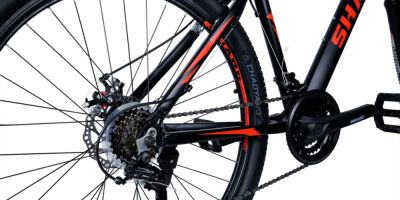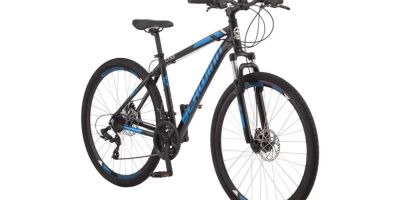Mastering Mountain Bike Gears: A Personal Guide to Shifting and Gear Efficiency
As someone who’s been mountain biking for years, I can confidently say that understanding your bike’s gears and shifting system can completely transform your riding experience. When I first started mountain biking, I was overwhelmed by the different gears and levers on my bike. But as I spent more time riding, I began to realize just how crucial it was to master these gears for a smoother, more efficient ride—whether I was tackling steep climbs, technical descents, or long trail rides. In this guide, I’ll break down how mountain bike gears work, the importance of shifting properly, and how you can improve your bike handling by understanding your bike’s gearing system.

Conte's Bike Shop
3449 Wilson Blvd, Arlington, VA 22201, USA
1. The Basics of Mountain Bike Gears
Mountain bike gears are essentially the system that helps you adjust the resistance on the pedals to match the terrain you're riding on. When you shift gears, you're changing the size of the gears that engage with the bike's chain, making it easier or harder to pedal depending on your speed, cadence, and the incline of the trail. In simple terms, gears allow you to optimize your effort for various conditions, whether you're climbing a hill, cruising on a flat trail, or speeding down a descent.
The basic gearing system of a mountain bike consists of a combination of two parts: the front chainring and the rear cassette. The front chainring is attached to the pedals, and it determines how much force you have to exert to turn the pedals. The rear cassette, on the other hand, consists of a set of cogs that are attached to the rear wheel hub. The cassette’s cogs come in different sizes, and shifting between them changes the resistance of the pedals.
The number of gears on a mountain bike typically ranges from 18 to 30 gears, with some high-end bikes even featuring more. More gears allow for a wider range of adjustments to your pedaling effort, which is particularly useful when riding on diverse terrain.

Bicycle Barn LLC
839 Reading Rd, East Earl, PA 17519, USA
2. How Do Mountain Bike Shifters Work?
Mountain bike shifters are the components that allow you to change gears. Typically, there are two types of shifters you will find on most mountain bikes: trigger shifters and twist shifters. Both serve the same purpose but operate differently. Understanding how these shifters work is key to efficiently shifting gears during your ride.
Trigger Shifters: These are the most common type of shifters and are often found on modern mountain bikes. Trigger shifters have two levers: one to shift up to a higher gear (making pedaling harder) and one to shift down to a lower gear (making pedaling easier). When I first started biking, I found these shifters intuitive and easy to use because of their precise movement.
Twist Shifters: Twist shifters work by rotating the handlebar grips to shift between gears. You twist one direction to shift to higher gears and the other direction to shift to lower gears. Though they may seem less common on modern mountain bikes, I’ve seen them used on older bikes and some entry-level models. Twist shifters are easy to use but can be a bit tricky if you need to make quick gear changes on more technical trails.
Regardless of the type, shifters send a signal to the derailleur, which then moves the chain to the correct cog on the cassette or the appropriate chainring at the front. The derailleur ensures smooth and accurate shifts, allowing you to keep up your momentum while riding.
3. When to Shift Gears on a Mountain Bike
Knowing when to shift gears is just as important as understanding how to shift. Over the years, I’ve learned that shifting at the right time can make a big difference in terms of maintaining momentum and reducing fatigue. Here are some general rules I follow for shifting at the right moment:
- Before You Start Climbing: If you know you’ll be approaching a steep incline, shift to a lower gear before you start pedaling up the hill. This allows you to maintain a smooth, steady cadence without overexerting yourself.
- During the Climb: While climbing, it’s important to shift early rather than waiting until you’re struggling to pedal. When you feel the resistance increase, shift to a lower gear to keep your cadence high and avoid putting too much strain on your legs.
- On Flat Terrain: For smoother riding on flat trails or roads, you’ll want to shift to higher gears to increase your speed without putting too much force into the pedals.
- Downhill: On descents, you may want to shift to a higher gear to allow for better control and to keep your speed in check. If you’re riding on a technical descent with tight turns or rocks, shifting to a higher gear can help you maintain better control and avoid spinning out.
One key takeaway I’ve learned is that shifting too frequently or at the wrong times can lead to inefficient pedaling, excessive chain wear, and even chain drop. It’s all about anticipating changes in the trail and adjusting your gears before you’re in a tough spot.
4. How to Shift Smoothly on a Mountain Bike
Shifting smoothly is a skill that takes time to develop. When I first started mountain biking, I often struggled with clunky shifts or skipped gears. However, I’ve learned a few tricks over the years that have helped me shift more efficiently and without issues:
- Pedal Consistently: Always keep a steady pedal stroke when shifting gears. If you shift while you’re not pedaling smoothly, you might hear the gears skip or grind, which can lead to chain damage over time.
- Shift One Gear at a Time: It’s tempting to shift multiple gears at once, but I’ve found that shifting one gear at a time gives me better control and avoids stressing the derailleur. Quick, multiple shifts can result in chain slack and skipped gears.
- Don’t Shift Under Full Pressure: When shifting, try to reduce the pressure on the pedals slightly. Shifting under full power can cause the chain to misalign or even snap. It’s better to shift when you’re in a lighter gear to make the transition smoother.
By following these simple tips, I’ve been able to make smoother shifts, which not only improves my riding efficiency but also prolongs the life of my bike’s components.
5. Common Mountain Bike Gear Problems and How to Solve Them
Over the years, I’ve encountered several issues with my mountain bike’s gears, but I’ve learned to troubleshoot and fix them on my own. Here are some of the most common problems I’ve faced with mountain bike gears and how I solved them:
- Skipping Gears: If your chain is skipping or jumping between gears, it’s usually a sign that the chain is stretched or the derailleur needs adjusting. I always check the tension on the derailleur and replace the chain if it’s too worn out.
- Chain Dropping: A dropped chain can be caused by improper shifting or a loose derailleur. I’ve learned that adjusting the derailleur’s limit screws or replacing the chainring can help prevent this issue.
- Shifting Delays: Sometimes, the chain won’t shift immediately when I press the shifter. This often happens when the cables are loose or dirty. A quick cleaning and tightening of the cables usually solves the problem.
Knowing how to fix these common issues has saved me countless trips to the bike shop. If you're looking to learn more about gear adjustments or need help with your mountain bike, visit our website, [Healthy Cycling], for top-notch service and expert advice on bike care.










